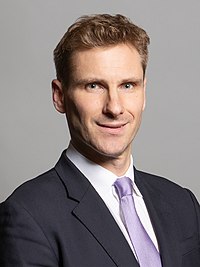Leader fantôme de la Chambre des communes
Apparence
| Leader fantôme de la Chambre des communes (en) Shadow Leader of the House of Commons | ||
 Logo de la Chambre des communes. | ||
 Titulaire actuelle Chris Philp depuis le (3 mois et 24 jours) | ||
| Création | vers | |
|---|---|---|
| Mandant | Chef de l'opposition officielle | |
| Premier titulaire | Herbert Morrison | |
| modifier |
||
Le leader fantôme de la Chambre des communes est un membre du cabinet fantôme au Royaume-Uni. Il est le pendant au sein de l'opposition officielle du leader de la Chambre des communes.
Leaders fantômes
[modifier | modifier le code]Notes et références
[modifier | modifier le code]- William Rees-Mogg, « This Bill is a panic measure in a tarnished age », The Times,
- « The Team Change », The Glasgow Herald,
- 31 March 1969 c 128.
- 21 May 1968 c 455.
- « Mr Heath's Team », The Glasgow Herald, , p. 8
- Associated Press, « Unity seen factor in Heath "cabinet" choices », Saskatoon Star-Phoenix, (lire en ligne)
- John Warden, « Wilson Gives Foot Key Market Role », The Glasgow Herald, (consulté le ), p. 22
- William Russell, « Wilson Gives Shore Key Prices Post », The Glasgow Herald, (consulté le ), p. 16
- « Higher Allowances for MPs », The Glasgow Herald, (consulté le ), p. 2
- « New Tory Post for Whitelaw », The Age, (consulté le ), p. 6
- Joseph W Grigg, « British Opposition Names New Spokesmen », St Petersburg Times, (consulté le ), p. 8A
- Geoffrey Parkhouse, « Pym favourite for top Thatcher post », The Glasgow Herald, , p. 1 (lire en ligne)
- House of Commons Debates 21 November 1979 c 1092. (The Prime Minister, James Callaghan, welcoming St John-Stevas to "his new post").
- House of Commons Debates 7 December 1979 c 1698. (St John-Stevas referring to his appointment as Shadow Leader).
- Geoffrey Pankhouse, « Shore Steps Up as Owen Is Demoted », The Glasgow Herald, (consulté le ), p. 1
- William Russell, « Foot's Soft Shoe Reshuffle », The Glasgow Herald, (consulté le ), p. 6
- Geoffrey Pankhouse, « Protest by Nationalists as Dewar Takes Over », The Glasgow Herald, (consulté le ), p. 7
- Ian Hernon, « Kinnock Cashes in on the Scots », Evening Times, (consulté le ), p. 7
- Geoffrey Pankhouse, « Kinnock Splits his Top Treasury Team », The Glasgow Herald, (consulté le ), p. 7
- Nicholas Timms, « Smith Revamps Shadow Cabinet », The Independent, (consulté le )
- Donald MacIntyre, « Commons inquiry to cover all MPs' fees », The Independent, (consulté le )
- Nicholas Timms, « Blair uses reshuffle to put own stamp on Shadow Cabinet: Brown stays as shadow Chancellor—Cook takes foreign affairs—Straw is shadow Home Secretary—Beckett moves to health », The Independent, (consulté le )
- « BBC Election 97: The Shadow Cabinet » [archive du ], BBC News
- « Opposition Front Bench », Weekly Information Bulletin, House of Commons Information Office,
- « Hague Reshuffles Shadow Cabinet », BBC News, (consulté le )
- Andrew Grice, « George Young to stand for Speaker », The Independent, (consulté le )
- Marie Woolf, « Hague Puts Thatcher Adviser on Front Bench », The Independent, (consulté le )
- George Jones, « I'll Never Scrap the Pound, Says Duncan Smith », The Telegraph, (consulté le )
- « Shadow Roles for Region's MPs », Cambridge City News, (consulté le )
- « Howard Reshuffles Top Tory Team », BBC News, (consulté le )
- Nick Assinder, « Cameron Forges Fresh Team », BBC News, (consulté le )
- « Clarke Returns to Shadow Cabinet », The Scotsman, (consulté le )
- « Tory 'Rations' MP Demoted », BBC News, (consulté le )
- « George Young replaces Alan Duncan as shadow leader of Commons », The Telegraph, (consulté le )
- « Alan Johnson Leads Shadow Cabinet Appointments », Channel 4, (consulté le )
- Notes
- Lloyd was Leader of the House before the Conservatives lost the 1964 election and was "retained" in the portfolio of "co-ordination of the Opposition in the Commons[2]. It is not clear whether the Conservative party at this point used the term "Shadow Leader" to describe the job[3], but the term was used[4].
- Edward Heath reshuffled the Conservative front bench after being elected leader in the summer of 1964, though he rejected the term "Shadow Cabinet" and instituted a "federal system", three Shadow ministers being in charge of a general area (foreign, economic, and home affairs). For example, Alec Douglas-Home headed foreign affairs, sitting above the Shadow Foreign and Defence Secretaries. The former members of the Shadow Cabinet remained, but three members had no specific responsibilities[6]. It is unclear whether Heath himself was in effect Shadow Leader of the House, as would have been common before the Second World War, or the responsibilities were assigned to one or more shadow ministers.
- Peart was Leader of the House going into Labour's election loss on 18 June 1970 and left the role of Shadow Leader of the House on 16 December 1971[7]. There is no evidence that anyone else served as Shadow Leader between those dates.
- In October 1978, Pym was made Shadow Foreign Secretary[12], and St John-Stevas succeeded him[13],[14].
























